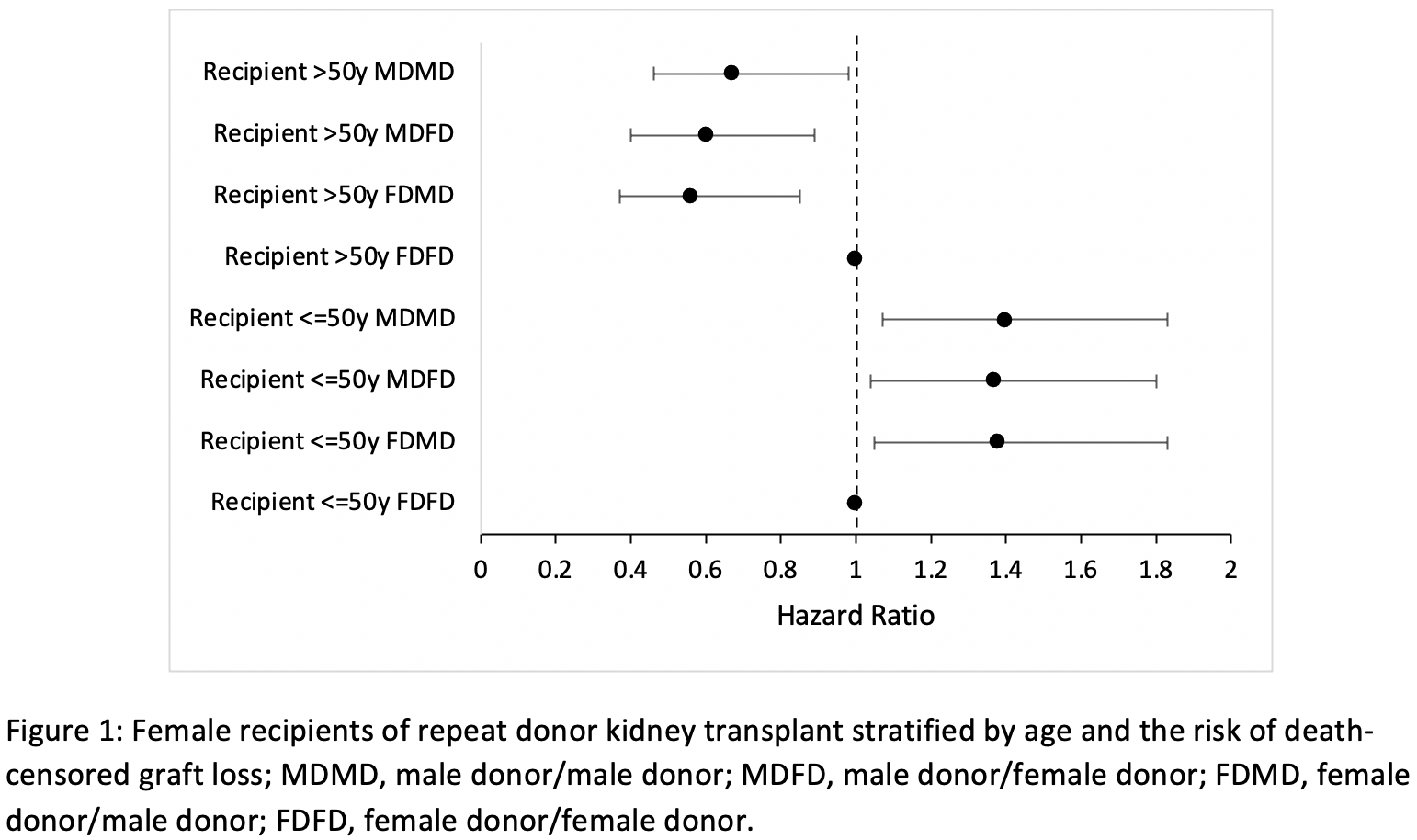The Role of Donor Sex in Females Undergoing Repeat Kidney Transplant: Does Prior Donor Sex Matter?
1Dalhousie University, Halifax, NS, Canada, 2Nova Scotia Health Authority, Halifax, NS, Canada
Meeting: 2022 American Transplant Congress
Abstract number: 842
Keywords: Allocation, Antibodies, Graft failure, Panel reactive antibodies
Topic: Clinical Science » Kidney » 47 - Kidney Complications: Immune Mediated Late Graft Failure
Session Information
Session Name: Kidney Complications: Immune Mediated Late Graft Failure
Session Type: Poster Abstract
Date: Saturday, June 4, 2022
Session Time: 5:30pm-7:00pm
 Presentation Time: 5:30pm-7:00pm
Presentation Time: 5:30pm-7:00pm
Location: Hynes Halls C & D
*Purpose: Female recipients of male donor kidneys are at increased risk for graft failure compared with all other donor-recipient sex pairings. The presumed mechanism relates to HY minor histocompatibility antigens on the Y chromosome that females are generally naïve to. Whether prior transplant with a male donor results in anti-HY antibody formation which may impact subsequent transplant outcomes, is unknown. Therefore, in this study we explore the effect of having a prior male versus female kidney donor on the risk of graft failure in a cohort of female recipients undergoing re-transplantation with a male versus female donor kidney.
*Methods: The SRTR was used to identify female recipients of a second deceased donor kidney transplant between 2000 and 2016. We included only those with complete data for donor and recipient sex and excluded living donors, patients <18 years of age at the time of re-transplantation, more than one prior transplant, and those receiving multiple organs. The primary outcome was death-censored graft loss (DCGL).
Female recipients were classified according to prior-current donor sex combination, (ie. male donor first-male donor second (MDMD); male donor first-female donor second (MDFD); female donor first-male donor second (FDMD); female donor first-female donor second (FDFD)). Multivariable Cox proportional hazards models were used to determine the association of each donor sex combination with the outcome of DCGL (relative to FDFD). In a secondary analysis we stratified results by recipient age >50 (pre-menopausal) or ≤ 50 years (post-menopausal) at the time of re-transplant.
*Results: A total of 5,594 female recipients underwent repeat kidney transplant. DCGL occurred in 1397 (25.0%) patients over a median follow-up time of 4.15 years (Q1 1.81, Q3 8.00). Prior-current donor sex pairing was not associated with DCGL in the overall cohort; the adjusted hazard ratio (HR) for DCGL relative to FDFD was (HR 1.04, 95% CI 0.83-1.30 for FDMD; HR 1.07, 95% CI 0.86-1.34 for MDFD; HR 1.10, 95% CI 0.89-1.37 for MDMD). However, when stratified by age at the time of second transplant, among recipients ≤50 years, FDFD was significantly lower risk for DCGL compared with all other donor sex pairings; among recipients >50 years FDFD was the highest risk for DCGL, Figure 1.
*Conclusions: Prior-current donor sex pairing did not impact the risk of DCGL in female recipients undergoing re-transplant overall. However, prior-current donor sex pairing was significantly associated with DCGL when stratifying by recipient age at time of re-transplant.
To cite this abstract in AMA style:
Craig S, Tennankore K, Vinson AJ. The Role of Donor Sex in Females Undergoing Repeat Kidney Transplant: Does Prior Donor Sex Matter? [abstract]. Am J Transplant. 2022; 22 (suppl 3). https://atcmeetingabstracts.com/abstract/the-role-of-donor-sex-in-females-undergoing-repeat-kidney-transplant-does-prior-donor-sex-matter/. Accessed December 27, 2025.« Back to 2022 American Transplant Congress

